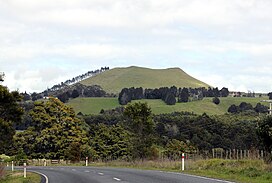Te Ahuahu
Appearance
| Te Ahuahu | |
|---|---|
 Te Ahuahu, looking from Waimate North | |
| Highest point | |
| Elevation | 373 m (1,224 ft) |
| Coordinates | 35°20′21″S173°50′28″E/ 35.339284°S 173.84109°E |
| Geography | |
 Te Ahuahu andesite (red) and basaltic scoria and lava field (brown) in centre of map.Tarahiis to the south. Clicking on the map enlarges it, and enables panning and mouseover of volcanic feature name/wikilink and ages before present. The key to the other volcanics that are shown with panning isbasalt- brown,monogeneticbasalts - dark brown, undifferentiated basalts of the Tangihua Complex in Northland Allochthon - light brown, arc basalts - deep orange brown, arc ring basalts -orange brown,dacite- purple,andesite- red, basaltic andesite`- light red,rhyolite- violet,ignimbrite(lighter shades of violet), andplutonic- gray. | |
| Geology | |
| Age of rock | Pleistocene |
| Mountain type | Basaltic scoria cone |
| Type of rock | Basalt |
Te Ahuahuis a 373 m high andesitic basalticscoria coneto the east ofLake Ōmāpere,in theKaikohe-Bay of Islands volcanic fieldinNew Zealand.
It was the site ofHōne Heke'spāthat was the scene of theBattle of Te Ahuahuduring theFlagstaff Warof 1845–46. Here on 12 June 1845 a Maori raiding party led byTāmati Wāka Nenecaptured the pā afterHōne Hekeleft it to gather food. During failed attempts to retake the pā,Hōne Hekewas seriously wounded when shot in the thigh and at least 30 of his men were killed or wounded.[1]
References[edit]
- ^"Puketutu and Te Ahuahu - Northern War".Ministry for Culture and Heritage - NZ History online. 3 April 2009.Retrieved7 January2023.
